| Part of a series on the |
| Philosophy of religion |
|---|
| Philosophy of religion article index |
Hell-fire preaching is a religious term that refers to preaching which calls attention to the final destiny of the impenitent, which usually focuses extremely on describing the painful torment in the Hereafter as a method to invite people to religion. There may be degrees of emphasis, and degrees of extent to which hell is emphasized in the khutbah (sermon or speech in Islam). [1] [2]
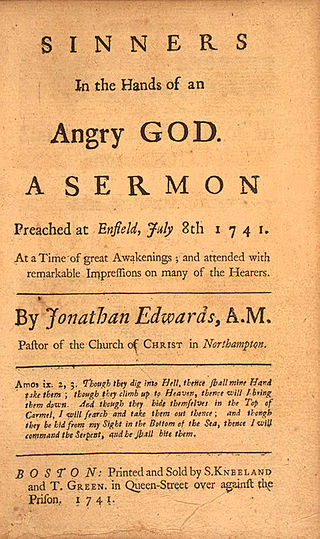
"Sinners in the Hands of an Angry God" is a sermon written by the American theologian Jonathan Edwards, preached to his own congregation in Northampton, Massachusetts, to profound effect, and again on July 8, 1741 in Enfield, Connecticut. The preaching of this sermon was the catalyst for the First Great Awakening. Like Edwards' other works, it combines vivid imagery of Hell with observations of the world and citations of Biblical scripture. It is Edwards' most famous written work, and a fitting representation of his preaching style. It is widely studied by Christians and historians, providing a glimpse into the theology of the First Great Awakening of c. 1730–1755.
The Great Awakening was a series of religious revivals in American Christian history. Historians and theologians identify three, or sometimes four, waves of increased religious enthusiasm between the early 18th century and the late 20th century. Each of these "Great Awakenings" was characterized by widespread revivals led by evangelical Protestant ministers, a sharp increase of interest in religion, a profound sense of conviction and redemption on the part of those affected, an increase in evangelical church membership, and the formation of new religious movements and denominations.
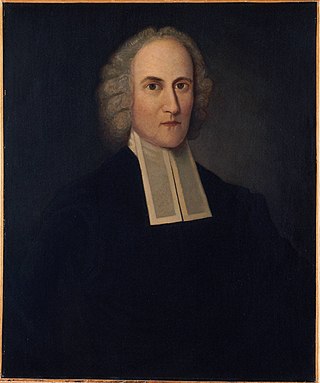
Jonathan Edwards was an American revivalist preacher, philosopher, and Congregationalist theologian.
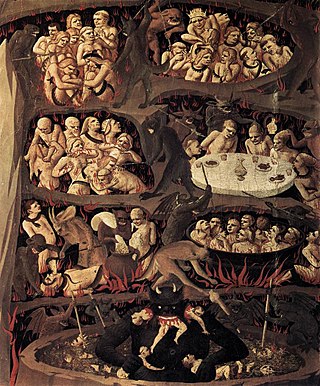
Damnation is the concept of divine punishment and torment in an afterlife for actions that were committed, or in some cases, not committed on Earth.

A sermon is a religious discourse or oration by a preacher, usually a member of clergy. Sermons address a scriptural, theological, or moral topic, usually expounding on a type of belief, law, or behavior within both past and present contexts. Elements of the sermon often include exposition, exhortation, and practical application. The act of delivering a sermon is called preaching. In secular usage, the word sermon may refer, often disparagingly, to a lecture on morals.

Charles Grandison Finney was an American Presbyterian minister and leader in the Second Great Awakening in the United States. He has been called the "Father of Old Revivalism." Finney rejected much of traditional Reformed theology.
Solomon Stoddard was the pastor of the Congregationalist Church in Northampton, Massachusetts Bay Colony. He succeeded Rev. Eleazer Mather, and later married his widow around 1670. Stoddard significantly liberalized church policy while promoting more power for the clergy, decrying drinking and extravagance, and urging the preaching of hellfire and the Judgment. The major religious leader of what was then the frontier, he was known as the "Puritan Pope of the Connecticut River valley" and was concerned with the lives of second-generation Puritans. The well-known theologian Jonathan Edwards (1703–1758) was his grandson, the son of Solomon's daughter, Esther Stoddard Edwards. Stoddard was the first librarian at Harvard University and the first person in American history known by that title

Fire and brimstone is an idiomatic expression referring to God's wrath found in both the Old and New Testaments. In the Bible, it often appears in reference to the fate of the unfaithful. Brimstone, an archaic term synonymous with sulfur, evokes the acrid odor of sulfur dioxide given off by lightning strikes. The association of sulfur with divine retribution is common in the Bible.
In Islam, Jahannam is the place of punishment for unbelievers and other evildoers in the afterlife, or hell. This notion is an "integral part of Islamic theology", and has "occupied an important place in the Muslim belief". It is often called by the proper name Jahannam. Simultaneously, jahannam is a term specifically for the uppermost layer of hell.

Nathaniel William Taylor was an influential Protestant Theologian of the early 19th century, whose major contribution to the Christian faith, known as the New Haven theology or Taylorism, was to line up historical Calvinism with the religious revivalism of the time. A graduate of Yale College, he returned to found the school's first independent division, the Theological Department, an institution which later became the Yale Divinity School.

The First Great Awakening or the Evangelical Revival was a series of Christian revivals that swept Britain and its thirteen North American colonies in the 1730s and 1740s. The revival movement permanently affected Protestantism as adherents strove to renew individual piety and religious devotion. The Great Awakening marked the emergence of Anglo-American evangelicalism as a trans-denominational movement within the Protestant churches. In the United States, the term Great Awakening is most often used, while in the United Kingdom, the movement is referred to as the Evangelical Revival.

The governmental theory of the atonement is a doctrine in Christian theology concerning the meaning and effect of the death of Jesus Christ. It teaches that Christ suffered for humanity so that God could forgive humans without punishing them while still maintaining divine justice. In the modern era it is more often taught in non-Calvinist protestant circles, yet also bearing in mind that Arminius, John Wesley and other Arminians never speak clearly of it. It is drawn primarily from the works of Hugo Grotius and later theologians like John Miley and H. Orton Wiley.
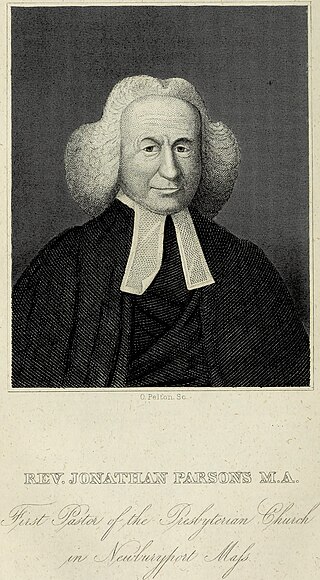
Jonathan Parsons was a Christian New England clergyman during the late colonial period and a supporter of the American Revolution. Born in West Springfield, Massachusetts, he was the youngest son of Ebenezer (Deacon) Parsons (1668-1752) and Margaret Marshfield of Springfield. Though intended for an artisan career, the Rev. Jonathan Edwards, then a tutor at Yale, persuaded young Parsons to prepare for college.
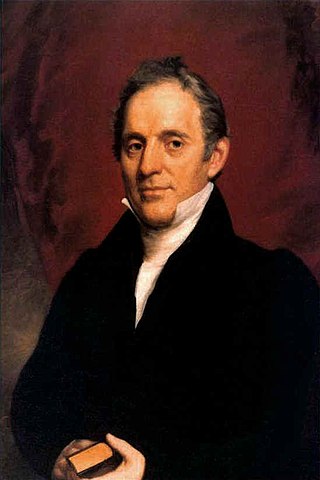
Asahel Nettleton was an American theologian and Evangelist from Connecticut who was highly influential during the Second Great Awakening. The number of people converted to Christianity as a result of his ministry was estimated by one biographer at 30,000. He participated in the New Lebanon Conference in 1827, during which he and Lyman Beecher opposed the teachings of Charles Grandison Finney.

New England theology designates a school of theology which grew up among the Congregationalists of New England, originating in the year 1732, when Jonathan Edwards began his constructive theological work, culminating a little before the American Civil War, declining afterwards, and rapidly disappearing after the year 1880.
The Justice of God in the Damnation of Sinners is a sermon by American Christian theologian, reformer, author, and pastor, Jonathan Edwards, originally published in 1734, that uses the text of Romans 3:19 as its basis.
Christian revivalism is increased spiritual interest or renewal in the life of a church congregation or society, with a local, national or global effect. This should be distinguished from the use of the term "revival" to refer to an evangelistic meeting or series of meetings. Proponents view revivals as the restoration of the church itself to a vital and fervent relationship with God after a period of moral decline.

Sarah Edwards was an American missionary and the wife of theologian Jonathan Edwards. Her husband was initially drawn to her spiritual openness, direct relationship with God, and periods of spiritual ecstasy. As a theological student at Yale, he had longed to have a personal relationship with God. His wife's experiences, similar to those of Saint Teresa of Ávila, profoundly affected his religious life and the formation of the New Light. She was a model of spirituality during the Great Awakening of the early 18th century. Her experiences of religious ecstasy were documented in Jonathan Edwards's work, Some Thoughts Concerning the Present Revival of Religion in New England. She was a Puritan who took her faith very seriously. She raised her eleven children, largely by herself, as Jonathan Edwards focused on sermons and books. Among her noted descendants, Sarah was the grandmother of U.S. vice president Aaron Burr.
Abu 'Abd Allah Muhammad ibn Karram al-Sijistani was an ascetic, hellfire preacher, hadith narrator, and a literalist theologian who founded the Karramiyya sect. His views were considered heretical, schismatic, and abominable by the majority of Sunni scholars. He was accused of holding the doctrine of anthropomorphism, and that his chief theological doctrine was that God is a substance (jawhar) and that he had a body (jism); for which reason his followers were commonly called the "Mujassima" (corporealists) and "Mushabbiha" (anthropomorphists).
In Islam, "the promise and threat" of Judgment Day, when "all bodies will be resurrected" from the dead, and "all persons" are "called to account" for their deeds and their faith during their life on earth. It has been called "the dominant message" of the holy book of Islam, the Quran, and resurrection and judgement the two themes "central to the understanding of Islamic eschatology". Judgement Day is considered a fundamental tenet of faith by all Muslims, and one of the six articles of Islamic faith.
But whereas his sermon "The Justice of God..." is the more satisfactory example of Edwards' hellfire preaching, it is his sermon preached at Enfield, Connecticut—"Sinners in the Hands of an Angry God"—by which later generations came to know Jonathan Edwards.
Perhaps the epitome of the image of the hellfire preacher is Jonathan Edwards, whose sermon 'Sinners in the Hands of an Angry God' depicted the realities of hell so clearly that it was said the hearers could smell the sulfur burning.
Most famous was Charles Grandison Finney (1792–1875), Presbyterian hell-fire preacher who used "protracted meetings," colloquial language, direct reference to name of people present, the "anxious bench" for those awaiting conversion, and other unusual methods.
C. S. Lewis was brought up in Northern Ireland where that extraordinary hell-fire preacher W. P. Nicholson had exerted so great an influence.
Apart from being an eminent theologian, Ibn Karram was also a hellfire preacher.